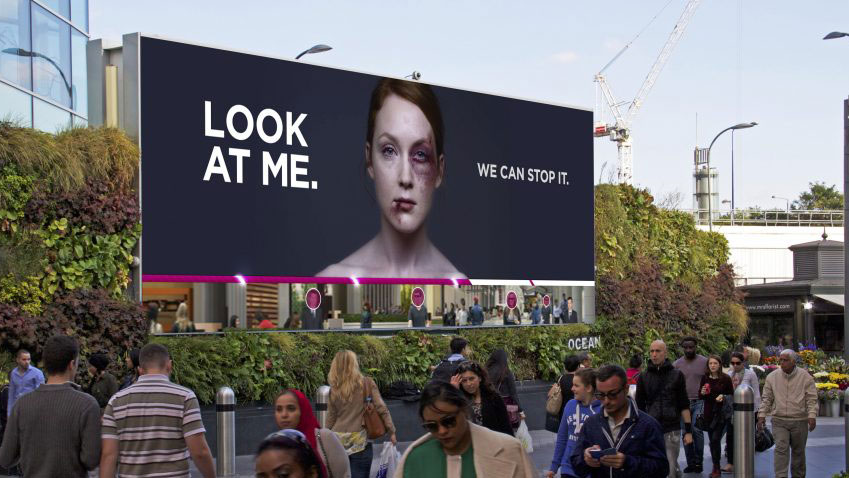The new frontier of advertising
WRCS’ Dino Burbidge reveals what’s on the cards in adland.

As director of innovation and technology at marketing and advertising agency WCRS, it’s Dino Burbidge’s job to jump on new technologies well before they make it into public consciousness. He spends his days figuring out the boundaries of what’s theoretically possible even when no one else has thought of trying something.
Last week, Burbidge spoke at Reasons.to, an award-winning festival of creativity held annually in Brighton, about the weird science of super-creativity. We caught up with him afterwards to find out what’s going on at the cutting edge of tech in advertising … and if we’re ready to handle it.
Face-tracking billboards
The latest game-changer in billboard advertising is face tracking. You may not realise it, but most billboards will now have a little camera on them for this very purpose. These discreet cameras are used to assess if more men or more women are seeing the display, and thus target which adverts should be shown there. There’s no personally identifiable information, but it’s a technology that nevertheless requires a responsible approach.
In 2015, WCRS made waves with a campaign for Women's Aid. The billboard showed a woman with a cut and bruised face. The tech registered when people were looking at the ad, and as they did so the injuries began to fade. The result was a powerful statement about not turning a blind eye to domestic abuse. “It’s a really interesting new thing,” Burbidge acknowledges. “That was using face tracking, and nobody questioned it because it was the right use.”
Now, however, Google is thinking of getting into billboards. “Google, they know where you are, what you're doing all the time. So they're using all that data to modify things. And I think we don’t possess the knowledge to even know that we need to question what's happening.”
I think we don’t possess the knowledge to even know that we need to question what's happening
Ethical dilemmas aside, the progression could potentially solve one of the biggest problems in the advertising industry: attribution. Let’s say someone buys a product on Amazon, Burbidge says. At the moment, that sale will be credited to the website that sent them directly to the Amazon. However, if you’re able to prove the same person walked past a billboard ad for that product 10 weeks beforehand, because they had their phone in their pocket at the time and you can trace their movements, you then know that the start of the journey was with the billboard, and the sale can be credited to that advertising effort.
“That attribution has been very vague up until this point,” he says. “So you're starting to see technology coming to advertising that can – if done brilliantly – it can help.”
Get the Creative Bloq Newsletter
Daily design news, reviews, how-tos and more, as picked by the editors.
Making it worthwhile
The key is in the value you exchange. If all the benefit is with the ad agencies, no one’s going to want to put their tracking data on all the time for that. Half of ‘millenials’, he says, want a website to be able to predict what they want. If it doesn’t, they’ll use an adblocker. “Help me out; don't be creepy”, is what we’re aiming for, Burbidge says. “It's interesting; we're just on that cusp.”
On the flip side, older generations push back against personalisation and instinctively don’t trust brands that do this. At the same time, they won’t ask questions of it in the same way that younger consumers typically will, making it much easier for ad agencies to hoodwink them, should they decide to.
We're not following technology; we are now dictating what technology, for us, is good technology
So while cutting-edge technology is opening exciting new doors, it’s how humans interact with this tech that really interests Burbidge.
“We've gone the last 30 years going 'technology is brilliant', and I think with Cambridge Analytica and Facebook, Trump, Brexit... we're now saying, ‘Hang on a minute, technology needs to work with humans a bit more’,” he says. “So we're not following technology; we are now dictating what technology, for us, is good technology. It's not how will technology affect creativity, it's how can we make sure that people value it as a tool and the audience value the human input into it.”
He uses the example of the Next Rembrandt project, sponsored by ING. In it, AI was fed all the other Rembrandt portraits, and it produced what would be the ‘next’ one based on that information. If both were valueless, and you gave someone the choice of between the two, Burbidge argues that most people would choose to own the AI-generated one, because of the interesting story behind it.
“The technology should be the thing that helps us as a tool,” he adds, “and not the thing that drives us into smaller corners.”
Read more:

Thank you for reading 5 articles this month* Join now for unlimited access
Enjoy your first month for just £1 / $1 / €1
*Read 5 free articles per month without a subscription

Join now for unlimited access
Try first month for just £1 / $1 / €1

Ruth spent a couple of years as Deputy Editor of Creative Bloq, and has also either worked on or written for almost all of the site's former and current design print titles, from Computer Arts to ImagineFX. She now spends her days reviewing small appliances as the Homes Editor at TechRadar, but still occasionally writes about design on a freelance basis in her spare time.
